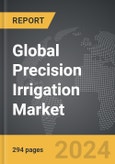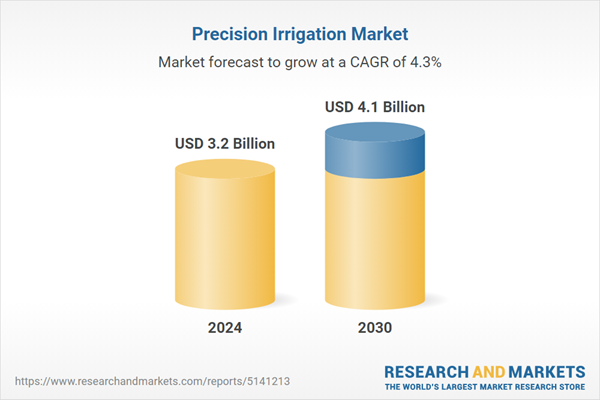The global market for Precision Irrigation was valued at US$3.2 Billion in 2024 and is projected to reach US$4.1 Billion by 2030, growing at a CAGR of 4.3% from 2024 to 2030. This comprehensive report provides an in-depth analysis of market trends, drivers, and forecasts, helping you make informed business decisions. The report includes the most recent global tariff developments and how they impact the Precision Irrigation market.
Segments: Application (Crop-based Application, Non-crop-based Application); Type (Sprinkler Irrigation, Drip Irrigation, Boom Irrigation System).
Geographic Regions/Countries: World; United States; Canada; Japan; China; Europe (France; Germany; Italy; United Kingdom; Spain; Russia; and Rest of Europe); Asia-Pacific (Australia; India; South Korea; and Rest of Asia-Pacific); Latin America (Argentina; Brazil; Mexico; and Rest of Latin America); Middle East (Iran; Israel; Saudi Arabia; United Arab Emirates; and Rest of Middle East); and Africa.
The analysts continuously track trade developments worldwide, drawing insights from leading global economists and over 200 industry and policy institutions, including think tanks, trade organizations, and national economic advisory bodies. This intelligence is integrated into forecasting models to provide timely, data-driven analysis of emerging risks and opportunities.
Global Precision Irrigation Market - Key Trends and Drivers Summarized
Precision Irrigation: Revolutionizing Water Management in Agriculture
Precision irrigation is an advanced farming technique that involves the accurate and efficient application of water to crops based on real-time data and field-specific conditions. This approach contrasts with traditional irrigation methods, which often apply water uniformly across fields, regardless of varying crop needs or soil moisture levels. Precision irrigation systems, consisting of sprinkler, drip and boom system, use technologies such as sensors, GPS, satellite imagery, and data analytics to monitor factors like soil moisture, weather conditions, and crop health, enabling farmers to deliver the right amount of water at the right time. By optimizing water usage, precision irrigation not only conserves water resources but also enhances crop yield and quality. This technology is crucial in addressing the challenges of water scarcity and the increasing demand for food production, making it a vital tool for sustainable agriculture.How Are Technological Advancements Enhancing Precision Irrigation?
Technological advancements have significantly enhanced the capabilities and effectiveness of precision irrigation systems. The integration of Internet of Things (IoT) devices and wireless sensor networks has improved the accuracy of soil moisture and environmental monitoring, providing real-time data that informs irrigation decisions. Advanced algorithms and machine learning models analyze this data to predict irrigation needs, taking into account factors such as crop type, growth stage, and weather forecasts. The development of smart irrigation controllers has further automated the process, allowing for remote management and adjustments via mobile devices. Additionally, the use of satellite and drone imagery enables precise mapping of field variability, helping farmers identify areas that require more or less water. These technological improvements have made precision irrigation more accessible, scalable, and efficient, driving its adoption in both small-scale and large-scale farming operations.What Are the Key Applications and Benefits of Precision Irrigation?
Precision irrigation is applied across various agricultural sectors, offering numerous benefits that contribute to sustainable and efficient farming practices. In arable farming, precision irrigation helps optimize water use for crops like corn, wheat, and soybeans, ensuring consistent growth and reducing the risk of water stress. In horticulture, where water needs can vary significantly between plant types and growth stages, precision irrigation supports the production of high-value crops such as fruits, vegetables, and flowers by delivering water tailored to specific crop requirements. In viticulture, precision irrigation is used to manage water stress in vineyards, which is crucial for maintaining grape quality and achieving desired wine characteristics. The primary benefits of precision irrigation include water conservation, improved crop yield and quality, reduced energy and labor costs, and minimized environmental impact. By enabling more precise and controlled water management, precision irrigation helps farmers achieve better outcomes while promoting sustainable agricultural practices.What Factors Are Driving the Growth in the Precision Irrigation Market?
The growth in the precision irrigation market is driven by several factors. The increasing awareness of water scarcity and the need for sustainable water management in agriculture are significant drivers, as precision irrigation offers a solution to optimize water use and reduce wastage. Technological advancements that enhance the accuracy, efficiency, and automation of irrigation systems are also propelling market growth. The rising demand for higher crop yields and quality, particularly in regions with limited water resources, is further boosting the adoption of precision irrigation. Additionally, government initiatives and subsidies promoting water conservation and the use of advanced agricultural technologies are contributing to market expansion. The growing adoption of smart farming practices and the integration of IoT and data analytics in agriculture are further driving the demand for precision irrigation systems. These factors, coupled with the continuous innovation in irrigation technologies, are driving the sustained growth of the precision irrigation market.Report Scope
The report analyzes the Precision Irrigation market, presented in terms of units. The analysis covers the key segments and geographic regions outlined below.Segments: Application (Crop-based Application, Non-crop-based Application); Type (Sprinkler Irrigation, Drip Irrigation, Boom Irrigation System).
Geographic Regions/Countries: World; United States; Canada; Japan; China; Europe (France; Germany; Italy; United Kingdom; Spain; Russia; and Rest of Europe); Asia-Pacific (Australia; India; South Korea; and Rest of Asia-Pacific); Latin America (Argentina; Brazil; Mexico; and Rest of Latin America); Middle East (Iran; Israel; Saudi Arabia; United Arab Emirates; and Rest of Middle East); and Africa.
Key Insights:
- Market Growth: Understand the significant growth trajectory of the Sprinkler Irrigation segment, which is expected to reach US$925.4 Million by 2030 with a CAGR of a 3.8%. The Drip Irrigation segment is also set to grow at 3.7% CAGR over the analysis period.
- Regional Analysis: Gain insights into the U.S. market, valued at $849.8 Million in 2024, and China, forecasted to grow at an impressive 7.2% CAGR to reach $861.7 Million by 2030. Discover growth trends in other key regions, including Japan, Canada, Germany, and the Asia-Pacific.
Why You Should Buy This Report:
- Detailed Market Analysis: Access a thorough analysis of the Global Precision Irrigation Market, covering all major geographic regions and market segments.
- Competitive Insights: Get an overview of the competitive landscape, including the market presence of major players across different geographies.
- Future Trends and Drivers: Understand the key trends and drivers shaping the future of the Global Precision Irrigation Market.
- Actionable Insights: Benefit from actionable insights that can help you identify new revenue opportunities and make strategic business decisions.
Key Questions Answered:
- How is the Global Precision Irrigation Market expected to evolve by 2030?
- What are the main drivers and restraints affecting the market?
- Which market segments will grow the most over the forecast period?
- How will market shares for different regions and segments change by 2030?
- Who are the leading players in the market, and what are their prospects?
Report Features:
- Comprehensive Market Data: Independent analysis of annual sales and market forecasts in US$ Million from 2024 to 2030.
- In-Depth Regional Analysis: Detailed insights into key markets, including the U.S., China, Japan, Canada, Europe, Asia-Pacific, Latin America, Middle East, and Africa.
- Company Profiles: Coverage of players such as Agsmart Pty Ltd., EPC Industrie' Ltd., Grodan (ROCKWOOL B.V.), Jain Irrigation Systems Ltd., Lindsay Corporation and more.
- Complimentary Updates: Receive free report updates for one year to keep you informed of the latest market developments.
Some of the 42 companies featured in this Precision Irrigation market report include:
- Agsmart Pty Ltd.
- EPC Industrie' Ltd.
- Grodan (ROCKWOOL B.V.)
- Jain Irrigation Systems Ltd.
- Lindsay Corporation
- Nelson Irrigation Corporation
- Netafim Ltd.
- Rain Bird Corporation.
- Rivulis Irrigation Ltd.
- The Toro Company
- T-L Irrigation Company
- Valmont Industries, Inc.
Tariff Impact Analysis: Key Insights for 2025
Global tariff negotiations across 180+ countries are reshaping supply chains, costs, and competitiveness. This report reflects the latest developments as of April 2025 and incorporates forward-looking insights into the market outlook.The analysts continuously track trade developments worldwide, drawing insights from leading global economists and over 200 industry and policy institutions, including think tanks, trade organizations, and national economic advisory bodies. This intelligence is integrated into forecasting models to provide timely, data-driven analysis of emerging risks and opportunities.
What’s Included in This Edition:
- Tariff-adjusted market forecasts by region and segment
- Analysis of cost and supply chain implications by sourcing and trade exposure
- Strategic insights into geographic shifts
Buyers receive a free July 2025 update with:
- Finalized tariff impacts and new trade agreement effects
- Updated projections reflecting global sourcing and cost shifts
- Expanded country-specific coverage across the industry
Table of Contents
I. METHODOLOGYII. EXECUTIVE SUMMARY2. FOCUS ON SELECT PLAYERSIII. MARKET ANALYSISSOUTH KOREAREST OF ASIA-PACIFICARGENTINABRAZILMEXICOREST OF LATIN AMERICAIRANISRAELSAUDI ARABIAUNITED ARAB EMIRATESREST OF MIDDLE EASTIV. COMPETITION
1. MARKET OVERVIEW
3. MARKET TRENDS & DRIVERS
4. GLOBAL MARKET PERSPECTIVE
UNITED STATES
CANADA
JAPAN
CHINA
EUROPE
FRANCE
GERMANY
ITALY
UNITED KINGDOM
SPAIN
RUSSIA
REST OF EUROPE
ASIA-PACIFIC
AUSTRALIA
INDIA
LATIN AMERICA
MIDDLE EAST
AFRICA
Companies Mentioned (Partial List)
A selection of companies mentioned in this report includes, but is not limited to:
- Agsmart Pty Ltd.
- EPC Industrie' Ltd.
- Grodan (ROCKWOOL B.V.)
- Jain Irrigation Systems Ltd.
- Lindsay Corporation
- Nelson Irrigation Corporation
- Netafim Ltd.
- Rain Bird Corporation.
- Rivulis Irrigation Ltd.
- The Toro Company
- T-L Irrigation Company
- Valmont Industries, Inc.
Table Information
| Report Attribute | Details |
|---|---|
| No. of Pages | 294 |
| Published | April 2025 |
| Forecast Period | 2024 - 2030 |
| Estimated Market Value ( USD | $ 3.2 Billion |
| Forecasted Market Value ( USD | $ 4.1 Billion |
| Compound Annual Growth Rate | 4.3% |
| Regions Covered | Global |









